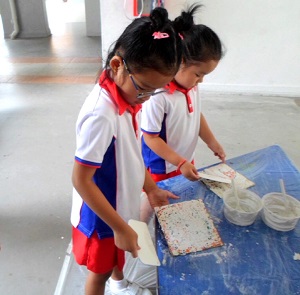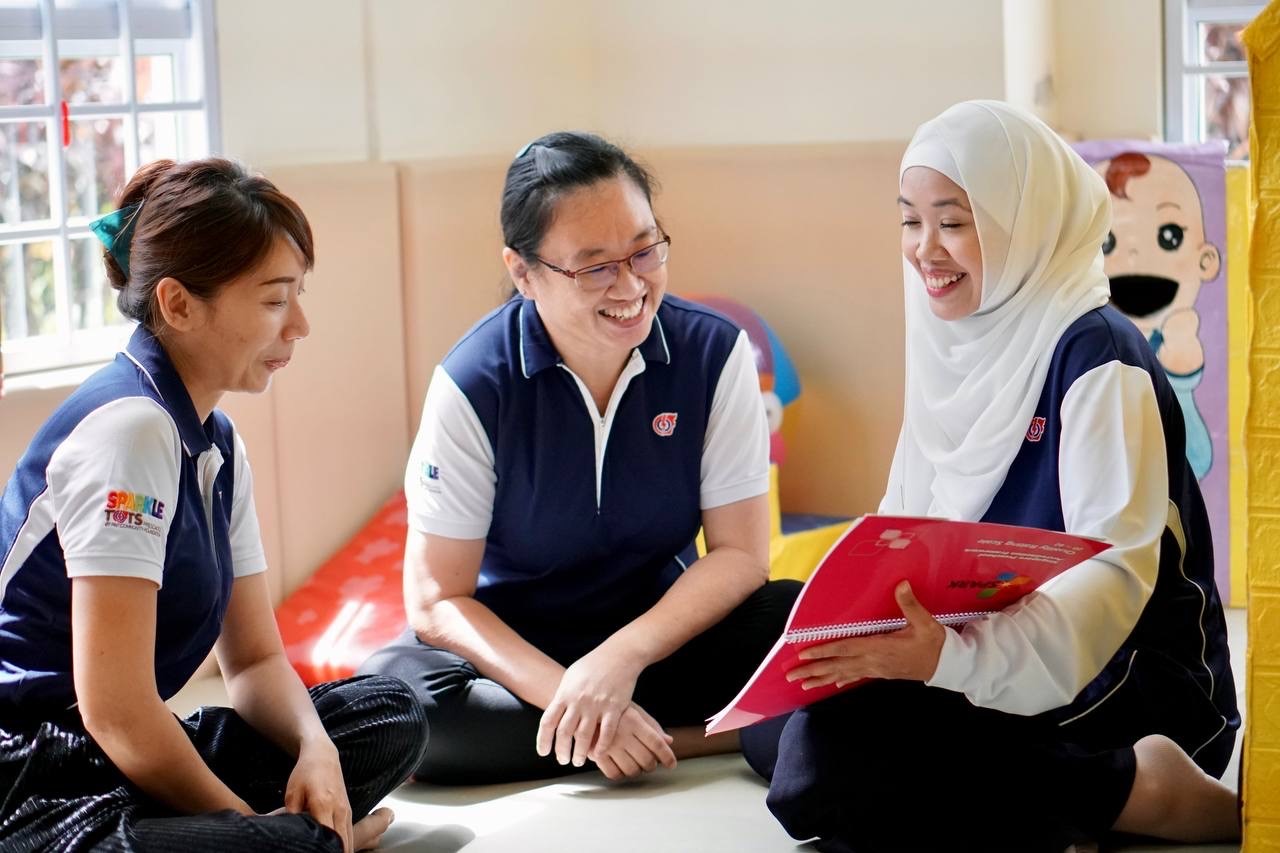Mosaic Art: Making Lessons Enriching Through Creative Art Expression
From afar, the artwork by pre-schoolers from PCF Sparkletots @ Blk 14 Geylang Serai may seem like a constellation of dots. However, go closer and one will realise they are actually beautiful artworks made up of small recycled tiles, created as part of the centre’s mosaic art project.

Bringing Inspiration To Life
Inspired by a picture she saw created from small recycled tiles, Ms Kalaivani D/O Elangovan (Vani), Vice-Principal of PCF Sparkletots @ Blk 14 Geylang Serai, decided to incorporate the art form into the lessons of her K1 students. The mosaic art project took off in 2017, when the centre had a timely opportunity to collaborate with the National Arts Council (NAC) and artist Ms Jane Soh, under the Artist-In-School Scheme (AISS).

But before Ms Vani and her teachers could implement the project with their preschoolers, they wanted to ensure they were sufficiently equipped with the necessary professional knowledge and skills to support the children in their learning.
Together with Ms Soh, the centre underwent staff training during the holidays, where they picked up the basics required to conduct their own mosaic art lessons. “Teachers found these training lessons beneficial,” shares Lead Centre Principal Ms Josephine Tan. “Teachers improved their pedagogical skills, and learned how to enhance the creativity in children and enable them to explore elements of the arts.”

Exercising their creative muscles, the teachers even developed their own ideas on how to extend the art technique, which typically used a wooden base, to create souvenirs like plant pots, mirror frames and table displays.
Mosaic Art In Action
When it was finally time for the teachers to share their knowledge and skills with their preschoolers, the children were quick to show interest in this art form. The project challenged and honed the abilities of the children in a variety of areas. For example, handling the small pieces of mosaic exercised their fine motor skills and hand-eye coordination, which are essential to reading and writing.

Teachers also noticed that their children’s math skills had improved. Children learnt about shapes, basic calculations, surface area and the best way to break down a larger area into smaller ones through mosaic tiling.
The children benefited on a social and emotional level too, learning the value of patience and self-control as they had to be courteous and patient in order to complete their artwork. Their teachers also observed greater discipline and perseverance among the children, as well as self-confidence and a sense of independence.
 |  |
“When thinking about how to teach patience, there is no better way than to have a child wait his or her turn for something enjoyable,” said Ms Tan.

Getting Parents Involved
Parent-centre partnership was key throughout the mosaic art project. Parents were roped in to support the project, volunteering in a range of roles from supporting special needs children to managing resources. More importantly, parents got the chance to work with their children, and through the process, were able to understand more about their child.

“The mosaic art workshops gave parents a chance to collaborate with their children. It also allowed parents to understand what excited their child, what engaged them, and why they found the mosaic art interesting,” said Ms Vicente Mary Khrisna Quiniones, preschool teacher.
During the two mosaic art workshops organised by the centre, which involved a total of seven teachers, 33 parents and their children at each session, the students proudly shared with their parents the skills they learnt while working on their art pieces. They correctly identified colours, demonstrated the orderly way to collect the tiles by waiting their turn, and showed how they traced pictures and pasted tiles onto the wooden base. For the parents, it was heart-warming and satisfying to see first-hand how much skills and confidence their children had gained.

“I had a great experience, and was happy to do it with my child. I encourage parents to get involved in such centre activities and spend more time with their kids,” said parent Mrs Uma Gurung.
Future Plans And Possibilities
Given the success they experienced, the centre plans to take the project further.
“Going forward, we plan to introduce mosaic craft to the N1 to N2 classes as well,” said Ms Tan.
The teachers involved also have words of encouragement for other centres keen on incorporating art into their lessons. They recommend starting small and progressing gradually. Field trips are also useful for kids to observe the process and develop an interest in the art form. Ms Tan also recommends group sizes of around 35 to 40 families to keep things manageable. Most importantly, teachers have to be well equipped to support and engage parents throughout the process.
“The Mosaic art curriculum was an interesting journey, filled with rich learning and holistic development. Children were able to display their individual creativity, and became more responsible and confident. Overall, it was a positive and successful learning experience.” Ms Vani shares.
EMBARK ON THE ARTIST-IN-SCHOOL SCHEME (AISS)
The AISS is a collaboration between NAC and ECDA to enhance the quality of arts education in preschools. It is a professional development programme where teachers will acquire knowledge and skillsets on a specific art form through hands-on training workshops with artist(s) and integrate the chosen art form into the curriculum.
Find out more about the AISS for preschools here!
All photographs were contributed by PCF Sparkletots Preschool @ Blk 14 Geylang Serai
69008e2b-b265-4ab8-b4b3-b6aed833c184.jpg?sfvrsn=bb1e7c7_1)





